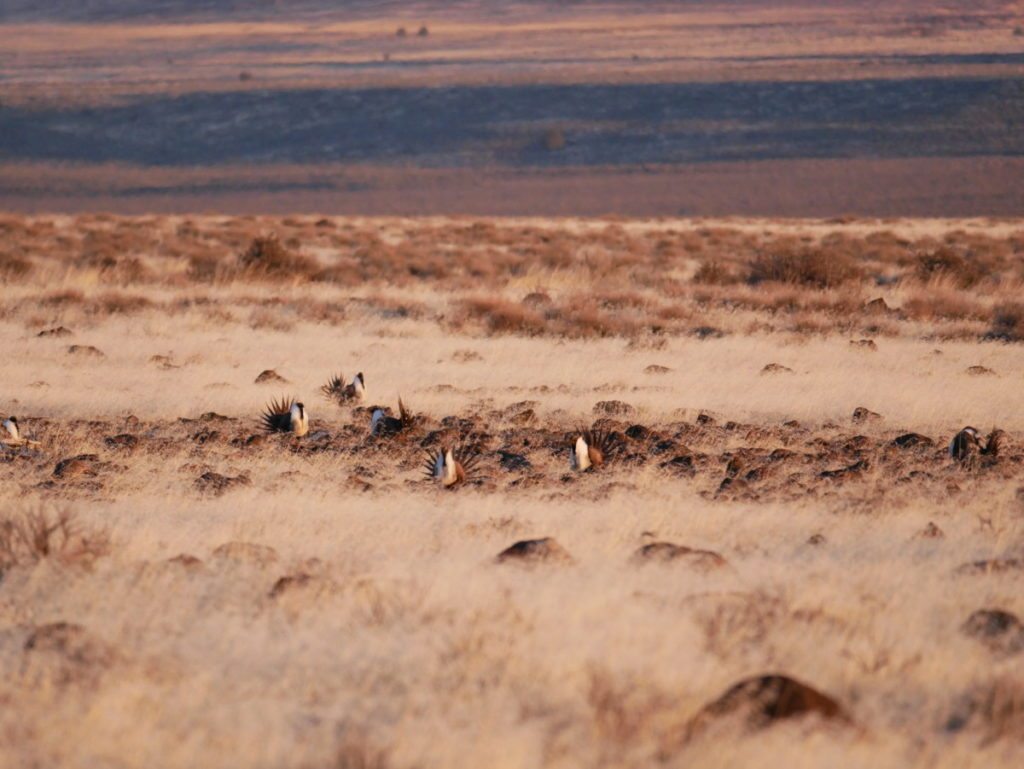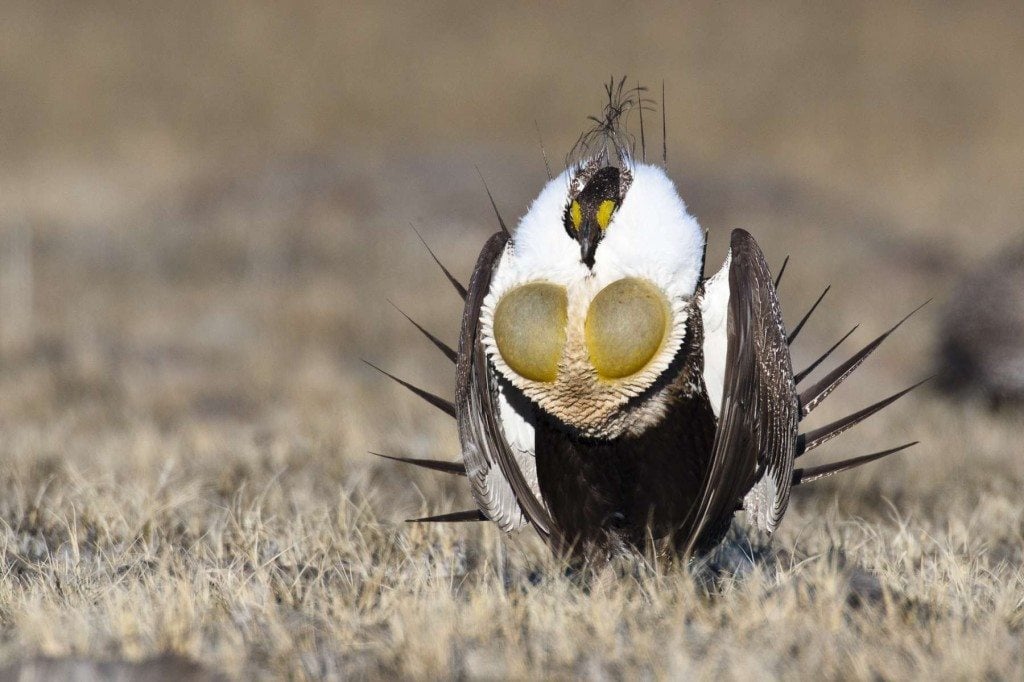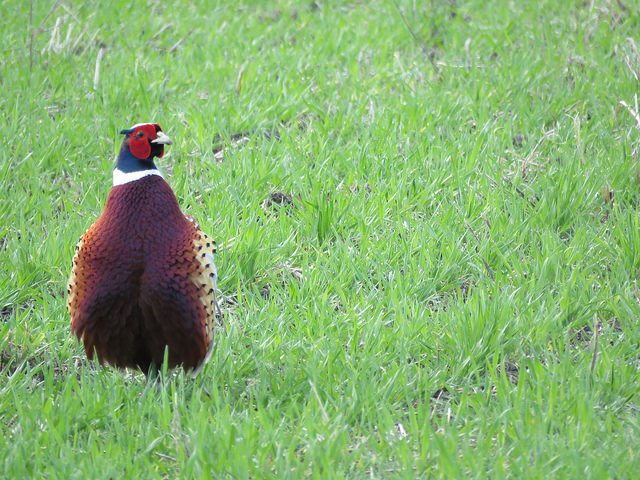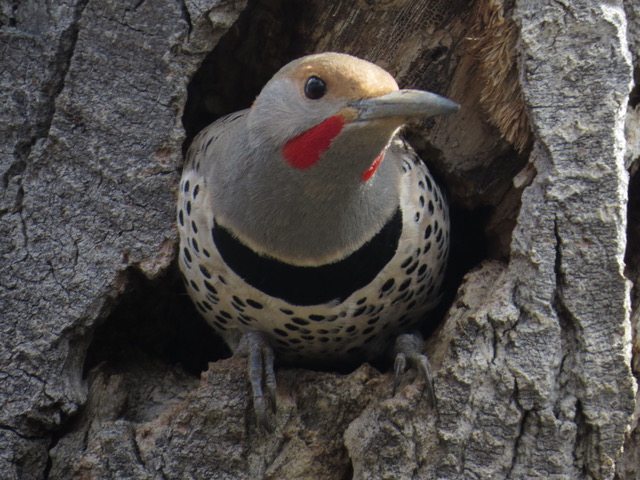Greater Sage-Grouse on their lek: unforgettable experience
By Maureen Lahiff
On a Golden Gate Bird Alliance trip in late March, an early adventure as part of Birdathon 2017, we had a long, full day of birding on Saturday and a wonderful morning on Sunday. We visited a number of areas around Susanville (Lassen County), and then caravanned to Honey Lake, Jack’s Valley, and Eagle Lake. We saw almost 90 species, including wintering geese, ducks, and other water birds; six hawks and both Golden and Bald Eagles; and sagebrush obligates. But we were there for one primary reason — the privilege of witnessing Greater Sage-Grouse (Centrocercus urophasianus) on a lek.
Greater Sage-Grouse mate on leks
Male Greater Sage-Grouse gather on open areas called leks to strut, dance, and sound off. They raise and fan their spiky tails, show off magnificent white ruffs, inflate bright yellow throat sacs, and make a sequence of distinct sounds, ending with a popping sound as they rapidly deflate their throat sacs, which can hold up to a liter of air. Males competitively display at dawn for up to three or four hours. They typically defend small patches of territory on the lek, just a few yards in diameter, very close to each other. Threat displays between males with lowered heads are common, but among Greater Sage-Grouse, charges and wing-battering seldom lead to injury.
Females choose which male to mate with based on male displays. Researchers have not completely sorted out the science of lekking behavior: Do the females come because the males have gathered and it’s an efficient way to compare them and select mates, or do the females gather and the males follow? What traits are the females looking for? Endurance? Other characteristics that define “fitness?” The male’s only contribution is genetic; the females incubate and raise the precocial chicks.



There are also a lot of evolutionary puzzles, as most of the females mate with a few dominant males.
However it works, birds are faithful to lekking sites generation after generation.
An Aldo Leopold morning
I would describe my lek experience early Saturday as an “Aldo Leopold morning.”
The meaning of this will become clearer as I describe the heart of the trip.
We gathered in Susanville at 4:45 a.m., under a starry sky with an old moon, 18 eager and expectant participants led by Dave Quady and Bruce Mast. We carpooled to an access road and hiked in by head lamp, trying to be as quiet as possible while helping each other get around deep ruts and muddy spots in the road. We heard the birds before we could see them: low-frequency pops from the males’ large air sacs, which can carry for as much as two miles.
We stayed at the edge of the road. We kept our distance to minimize sound and visual disturbances, sharing views through our scopes. As the sun came up, we got good looks in the warm light. There were 24 or 25 males gathered to display. Since the guys like areas with low vegetation and good visibility, we could see them. We saw only four or five females; Dave said it’s likely that many females were already on their nests.
There’s a link to a good sound recording at the Cornell Lab’s allaboutbirds website. You can find some great videos on the Internet, with better close-ups than we got. (Click here to view a short video of the lek by trip participant John Colbert.)
In videos, you can hear the swishing sounds when the males’ neck pouch feathers brush their wings. But the experience was so much more.
It’s simply an unforgettable experience to view the lek at dawn, a large patch of habitat that is still relatively undisturbed, and observe a ritual that has gone on for over 10,000 years. When I summed up my reaction to the lek at dawn for Dave Quady as “an Aldo Leopold experience,” I knew he shared my love for Leopold’s writing, appreciation of nature, and above all, his conservation legacy.
When Aldo Leopold wrote “Marshland Elegy” in 1937 about the dawn experience of hearing Sandhill Cranes arriving on the Wisconsin River, he assumed that they were on an inevitable path to extinction. You can find this essay collected in A Sand County Almanac, and it is easy to find on the Internet. Leopold was wrong about the cranes, and I hope that we’ll be able to say the same about the Greater Sage-Grouse.
2015: a vulnerable victory
In 2015, after much study, the U.S. Fish and Wildlife Service decided not to list the Greater Sage-Grouse under the Endangered Species Act.
National Audubon, the Cornell Lab of Ornithology, and other bird conservation organizations considered this a victory. Why a victory? Because so much work had gone into land-use planning; education and cooperative agreements with ranchers; efforts to protect and restore sagebrush steppe, prevent further habitat fragmentation and degradation, and preserve corridors for movement from wintering grounds, leks, and nesting habitat; and creation of buffer zones around leks and crucial habitat under the U.S. Bureau of Land Management, where oil and gas exploration is banned. Populations will continue to be monitored.
So the fragile conservation victory is this: Instead of having to make a recovery plan to retrieve a species from the brink of extinction, much hard work and energy arrested the bird’s decline before it had to be listed.
Yet it remains very touch-and-go for the Greater Sage-Grouse. They are still hunted, with quotas and permits. The International Union for Conservation of Nature (IUCN) lists them as “Near Threatened,” Audubon’s WatchList codes them as Yellow for rare or declining, and they are a California Species of Special Concern. Audubon also lists them as climate-endangered.
On top of all this, the Trump Administration and Republicans in Congress are considering changes in western land management that would unravel many of the hard-fought gains and strip protections from the Sage-Grouse. You can read more at audubon.org/news/an-unknown-future-greater-sage-grouse.


Greater Sage-Grouse is a classic “umbrella species.” Saving its habitat — the sagebrush ecosystem, also called the sagebrush steppe and the sagebrush sea (the title of a great PBS video) — will save the habitat of a wide array of other species of plants and animals.
It’s up to us, who have the opportunity to experience the awe and wonder of this keystone species, to do what we can to insure that Greater Sage-Grouse continue to dance on leks in healthy sagebrush steppes.
Participants in the Sage-Grouse field trip donated $2500 as part of Birdathon 2017 – funds which will support Golden Gate Bird Alliance’s conservation and education activities. Our next Birdathon will take place throughout April 2018 (and for special trips like this one, maybe a little earlier). Want to get involved in planning Birdathon 2018 in the fall? Email Ilana at idebare@goldengatebirdalliance.org.
Maureen Lahiff, a Lecturer at the U.C. Berkeley School of Public Health, is Chair of GGBA’s Adult Education Committee. She has previously written blog posts on shorebird migration, birding at Oakland’s Middle Harbor Shoreline Park, pelagic birding for beginners, docenting at Lake Merritt, and birding with GGBA in Yosemite and Oregon.
